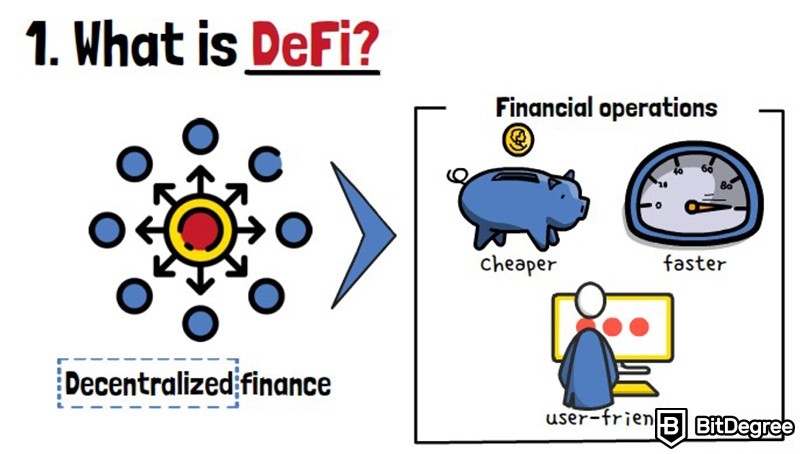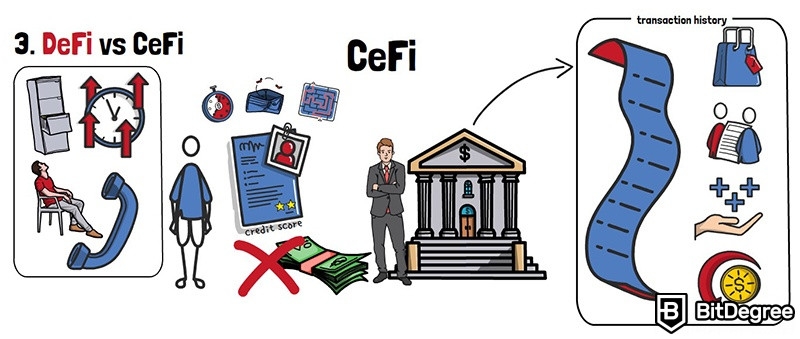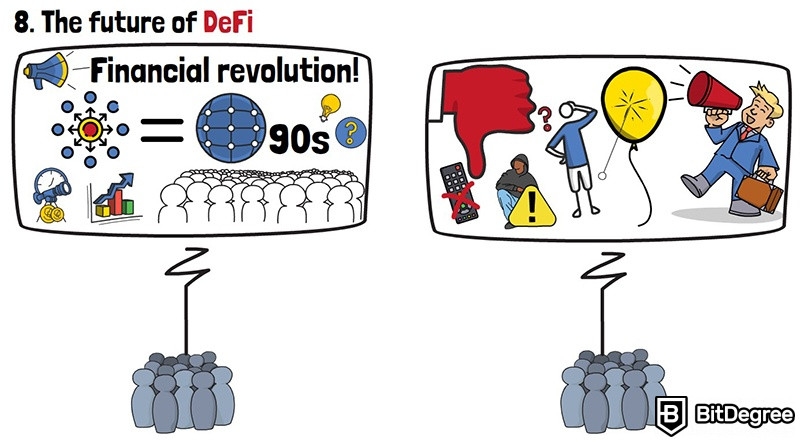What is Decentralized Finance (DeFi)?
In this section, I’ll explain to you what is DeFi, also known as decentralized finance!
If you were to take a look at Google Trends DeFi-term-related topics, you’d notice that this crypto sector has literally exploded sometime around October 2020, and YES, it has been climbing up in usage and popularity ever since. Just as there are skeptics, there are also many people who believe that decentralized finance will be the true future of the monetary system we have today, both on a local and a global scale.
Here, we’ll unravel what DeFi is. Furthermore, we’ll take a look at how DeFi is different from all of the traditional financial tools that are common nowadays, and also elaborate on the potential future of the sector, as well.
Without wasting any time, let’s get right to it!

Video Explainer
Video Explainer: What is Decentralized Finance (DeFi)?
Reading is not your thing? Watch the "What is Decentralized Finance (DeFi)?" video explainer
What is DeFi in Crypto? (Explained with Animations)


What is DeFi?
So, as I mentioned before, the term “DeFi” is an abbreviation of “decentralized finance”. We’ll break it down in a second, but in general, DeFi refers to a new type of financial operations that are considered to be much faster, cheaper, and more user-friendly than those complicated ones we are currently used to.
The term “decentralized” simply means that there is no single authority behind the concept. Instead, it belongs to the masses - the community behind the concept is in-charge of its development, and all decisions are made via a democratic vote, instead of a single CEO, director, or even the secret Illuminati family telling everyone what to do.

Imagine a grocery store. By default, the store would be owned by a single person - the store owner would be in charge of making all of the important decisions, while each of the employees would be responsible for their own duties within the store. If the owner made some bad decisions, and the store would go bankrupt, the employees would become jobless, even though they did nothing wrong.
In other words, this places a huge responsibility on a single individual, or a couple of people. If the same store was governed via a decentralized model, there would be no single store owner - instead, all of the employees would be responsible for the well-being of the establishment, and would make decisions by voting on proposals.
In general, decentralization is a hot topic in crypto, and this is especially true in the field of finance. DeFi offers a new way to view and interact with services such as lending and borrowing, banking, money safekeeping, gambling, and much more. Today, the entire premise of decentralized finance is built on blockchain technology.
Blockchains are essentially places where data is kept.
It’s like a folder on your computer, containing a heap of different photos. Instead of the folder, though, you have the blocks, and instead of your computer where these folders are stored, we have the blockchain, a distributed network of those folders. Finally, just imagine that this computer and folders on it can be accessed and viewed by anyone around the world, hassle-free (if the blockchain is public, that is - most of them are).
The blocks of data are connected with virtual chains - this means that the information is stored chronologically, and each new block references the one before. In other words, if you bought an apple and then a chocolate bar the next day, you won’t be able to prove that the chocolate purchase came first. And yes, it’s wrongly assumed that blockchain data is ultra-private. It’s not!
To your surprise, on the contrary, all your actions on the public blockchain are visible. Anyone can go to the blockchain explorer and easily check who, when, to whom the funds were sent, and what the value of the transaction was. Even what fees were paid for this transaction are visible.

Probably, you’ll think: Oh man, it’s so bad!
But you know what? This is the whole beauty of crypto, and what makes it special! All these types of features are very essential to DeFi!
Now, think of it this way: One day you decided to take a loan, let's say, for your dream car! You get yourself to the bank, and start arranging the details with the manager. Everything seems to be going great, up until the point when the manager decides to check your credit score.
Maybe you’re late on paying back a previous loan? Perhaps you’ve had some other financial issues that you might have solved, yet the credit score doesn’t show that?
Well, the manager would check your financial history - the purchases and transactions that you’ve made, any previous loans that you’ve taken out, your debts, and so on. If, say, your credit score is bad, as sad as it is, the manager will deny your loan, and that dream car will have to wait!
On top of that, the whole entire process will take quite a while to go through - you’d have to wait in queues, dig up all sorts of documents, make a wide array of phone calls, and so on. This is tedious and tiring!
In decentralized finance, all of these processes can be done instantly, thanks to the earlier-mentioned chronological data storage quality!

Now, if you’d like to learn what types of data can be stored on blockchains, or are interested in studying blockchain technology a bit further, you can check out the section on blockchains, too!
So, in essence, decentralized finance is a new wave of financial concepts and ideas that allow individuals like you and me to ditch traditional centralized finance institutions, and access the tools that many consider being the future of finance. Is that really true, however - and how is DeFi different from traditional centralized financial institutions?
Let’s explore these questions further.
How is DeFi Different From Traditional Finance?
This is where we get into the differences between traditional and decentralized finances.
Imagine that, on the table in front of you, there are two cups - one of them is old and worn down, with a broken handle and even some bruises. But, you can still drink coffee or tea from it, no problem! The other cup is brand new, shiny, and decked down with various ornaments - it might even have your favorite rock band’s logo engraved into it!
There’s just one catch, though - it doesn’t have a bottom. So, any drink you pour into it will simply spill right through.
No matter how cool the new cup might be, it does not serve its essential, primary purpose, and thus, can be rendered useless. The same is true when it comes to DeFi, as well - no matter how interesting and groundbreaking the concept of decentralized finance might be, if it doesn’t perform all of the same essential functions as traditional finance tools, it’s not really viable to be used, now is it?
Well, while DeFi is still a relatively new concept, I’m happy to say that there are already multiple apps out there that allow you to swap current, common financial tools for DeFi-powered ones. That being said, why would you do so, in the first place?
Decentralized finance aims to improve on many of the issues present with traditional finance. These issues include transaction speeds, their costs, various restrictions imposed by banking institutions, and the fact that your money can be taken from you, at any point in time.
Let’s take a look at a couple of examples.
Imagine that you open a bank account, and put your money into it. Money that you’ve saved your entire life! Now, you’ve decided that it’s time to put it in a savings account so that you could feel assured that your money’s safe.
Suddenly, a financial crisis comes and hits the world - everyone’s panicking, prices start not making sense, and banks all around start limiting user operations, and even denying users access to their accounts, in general! Then, you find out that the bank that you’ve placed your money in has just gone bankrupt!
In a situation like this, it’s highly likely that you won’t get your money back - all of your life’s savings, down the drain. Perhaps you wanted to build a house, or buy that dream car that we’ve talked about earlier? Chances are that the bank will be fine - it will get bailed out. Your money, on the other hand, might not.
Here, DeFi negates this scenario - since your money wouldn’t be stored with a single institution, and would be taken care of in a decentralized fashion, there wouldn’t be an institution that could go bankrupt, in the first place!
Decentralized finance also makes it much cheaper and faster to send money to your friends or relatives, as well! With traditional banking institutions, you’ll have to pay a (usually) high transaction fee, and wait for a few days for the money to reach your friend’s bank account, especially if they’re located on the other side of the world.
DeFi makes transactions happen in a matter of seconds, and tends to cost a fraction of the fee that you'd pay otherwise.
Before we continue with this section, you might be wondering - what sort of money would we be using in DeFi? USD? EUR? Or something else?
That’s a valid question to ask, too! Decentralized finance mostly revolves around what are called “stablecoins”. Essentially, these are digital US dollars that are created with the help of the earlier-mentioned blockchain technology.

It’s like, when you purchase something online, and make a payment with USD, technically you’re paying with digital money! Stablecoins are just like that, except that they are also based on blockchains, which makes them much more secure and reliable to use.
So, DeFi is cool and all - however, it’s also worth acknowledging that it’s not free of criticism, either!
You can view DeFi as a spicy meal - one that you are offered when you go to your friend’s house. It would be rude to say “no”, so you accept the offer. However, two bites into it, you can feel that you simply won’t be able to finish it - it’s too spicy! You COULD build a tolerance to spiciness over a long period of time, but why would you want to do that, in the first place?
Following this example, DeFi brings a lot of interesting innovations to the table - thus, many people are definitely interested in trying decentralized finance tools out. That said, many of those said tools and applications are still far too difficult and confusing (too spicy) to be adopted by the masses, and you have to be an actual technology enthusiast in order to use them!
Furthermore, it’s also worth mentioning that, to this day, the DeFi sector is full of malicious individuals who are constantly trying to scam users out of their money. In order to become the standard form of finance, DeFi would need to find a reliable way to weed these bad actors out, and ensure that the space is safe to be used for the average individual.
What is the Future of DeFi?
Now that you know what is DeFi, and have a better understanding of how it’s different from traditional financial tools, we can make some educated guesses about how this space will develop in the near future, too!
Essentially, there are two groups of people here - those that think DeFi is the new financial revolution, and that it will become the norm of how we deal with all-things finance, and others who are much more skeptical about it.
The first group of people views DeFi as the internet, in the late 90s. Back then, the internet was an innovation, and no one knew where it would go - would people use it? Is it too difficult for the average individual? What can the internet be used for, apart from reading articles and writing emails, in the first place? There were a lot of questions, and everyone was excited, yet reluctant to see what would happen next!
If DeFi is currently at the stage that the internet was back in the 90s, we can expect some unprecedented growth in the sector, in the near future. The more people will take on this new form of dealing with money, the faster will decentralized finance will become the norm, and the more uses the sector will have, too!
However, skeptics believe that DeFi is just a “bubble” - an overhyped concept that will end up crashing and failing, at the end of the day. Such beliefs mostly stem from the earlier-discussed problems that the DeFi sector is still experiencing - the difficulty of usage, scammers being present in the space, lack of regulation, and so on.

So, the question remains - is DeFi really the future of finance, or is it just another idea that will get lost in the history books?
All of that said, I hope this section helped you to learn about DeFi. You can continue learning in this "Bitdegree Crypto 101 Handbook", for instance, by reading about NFTs.










